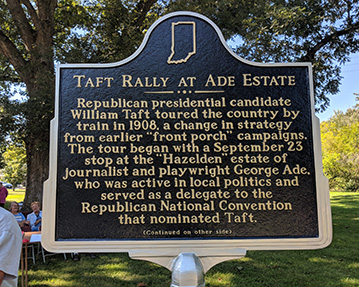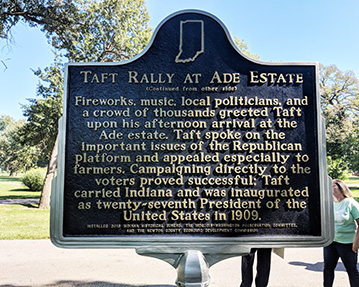Taft Rally at Ade Estate


Location: 3690 E State Road 16, Brook (Newton County, Indiana) 47922
Installed 2019 Indiana Historical Bureau, the Iroquois-Washington Preservation Committee,
and the Newton County Economic Development Commission
ID#: 56.2019.3
![]() Visit the Indiana History Blog to learn more about this "Republican Game-Changer: 1908 Taft Rally in Indiana."
Visit the Indiana History Blog to learn more about this "Republican Game-Changer: 1908 Taft Rally in Indiana."
Text
Side One
Republican presidential candidate William Taft toured the country by train in 1908, a change in strategy from earlier “front porch” campaigns. The tour began with a September 23 stop at the “Hazelden” estate of journalist and playwright George Ade, who was active in local politics and served as a delegate to the Republican National Convention that nominated Taft.
Side Two
Fireworks, music, local politicians, and a crowd of thousands greeted Taft upon his afternoon arrival at the Ade estate. Taft spoke on the important issues of the Republican platform and appealed especially to farmers. Campaigning directly to the voters proved successful; Taft carried Indiana and was inaugurated as twenty-seventh President of the United States in 1909.
Summary
During the 1908 presidential campaign, both major party candidates toured the country to appeal directly to voters. This marked a shift from the traditional “front porch” campaigns where candidates spoke to assembled reporters and audiences on political issues from their own homes. In fact, the roots of our modern political spectacle of aggressive campaigning can be found in the active campaigns of Republican William Howard Taft and Democrat William Jennings Bryan.
Before securing the Republican presidential nomination in July 1908, Taft served as U.S. Solicitor General, Circuit Court of Appeals judge, and as civil governor of the Philippines (then a U.S. protectorate). He became a close advisor to President Theodore Roosevelt, who appointed him U.S. Secretary of War in 1904. When Roosevelt decided not to run for reelection, he personally endorsed his friend Taft for the job. Roosevelt was popular with voters and his support gave Taft a valuable advantage.
The September 1908 decision of Taft and the Republican Party leadership to have the candidate tour the country by train and directly address the constituency was made in large part to repair Taft’s image. As a judge he had often sided against labor, for example, deciding against the workers of the Chicago Pullman Strike in 1894. The Republican Party needed to be seen as more progressive and as the friend of the working man. Thus, it was important for Taft to assure farmers and laborers that the Republican Party had their interests in mind, to draw attention to aspects of the Republican Party platform that would appeal to them, and to come off as a likeable man of the people.
Meanwhile in the Hoosier state, the Indiana Republican Party was split over the temperance issue (prohibition or local option). Local leaders hoped that a visit from a national candidate could unify the party, at least for long enough to push through a Republican state ticket. Charles S. Hernly, Chairman of Indiana's State Republican Committee, planned an enormous rally for the state’s farmers at the estate of George Ade, inviting local and national Republican candidates.
George Ade was a native of Newton County, a beloved Indiana author, and a dabbler in local politics. He lived on a large estate just outside Brook, Indiana, that he named “Hazelden.” Ade had also served as a delegate to the Republican National Convention in Chicago that nominated Taft as well as a member of the Notification Committee. While Ade was at first reluctant to host such a large event, he wanted to support the efforts of the Party. Taft accepted Hernly’s invitation and announced that his national tour would begin September 23, 1908 at Ade’s estate.
The day included elaborate decorations, music, fireworks, a barbecue, and speeches by local politicians. Thousands of farmers and their families attended. Taft spoke directly to their concerns, assuring them that the Republican Party was working to increase farm prosperity through maintenance of the gold standard and programs like free rural mail delivery. Taft’s strategy was successful in Indiana and the country. While democrats swept the state ticket, Taft won Indiana by over 10,000 votes. He won 321 electoral votes and 51.6% of the popular vote, an overwhelming victory. Taft was inaugurated March 4, 1909 as the 27th President of the United States and served until March 4, 1913.
Annotated Text
Taft Rally at Ade Estate
Republican presidential candidate William Taft[1] toured the country by train in 1908,[2] a change in strategy from earlier “front porch” campaigns.[3] The tour began with a September 23 stop at the “Hazelden” estate [4] of journalist and playwright George Ade,[5] who was active in local politics and served as a delegate to the Republican National Convention that nominated Taft.[6]
(365 characters w/ spaces)
Fireworks, music, local politicians, and a crowd of thousands greeted Taft upon his afternoon arrival at the Ade estate.[7] Taft spoke on the important issues of the Republican platform and appealed especially to farmers.[8] Campaigning directly to the voters paid off; Taft won Indiana and was inaugurated as the twenty-seventh President of the United States in 1909. [9]
[1] “Taft Wins on First Ballot: Secretary of War Gets 702 Votes – His Nomination Made Unanimous,” New York Tribune, June 19, 1908, 1, accessed Chronicling America, Library of Congress, https://chroniclingamerica.loc.gov/lccn/sn83030214/1908-06-19/ed-1/seq-1/; “Republican Convention at Chicago Selects Taft and Sherman to Head the National Ticket,” Bennington Evening Banner, June 19, 1908, 1, accessed Chronicling America, Library of Congress, https://chroniclingamerica.loc.gov/lccn/sn95066012/1908-06-19/ed-1/seq-1/; George Ade to William Howard Taft, June 20, 1908 in in Letters of George Ade, ed. Terence Tobin (West Lafayette: Purdue University Press, 1998),43; “Presidential Election of 1908: A Resource Guide,” Virtual Services, Digital Reference Section, Library of Congress, accessed https://www.loc.gov/rr/program/bib/elections/election1908.html.
Indiana delegates to the June 19, 1908 Republican National Convention in Chicago first supported Hoosier Charles W. Fairbanks during the nomination process. However, when Taft won on the first ballot, Hoosier delegates, including George Ade, heartily threw their support behind Taft. Ade wrote the next day to congratulate Taft. See footnote 6 for more on Ade at the convention
[2] “Taft’s Itinerary for Western Trip,” New York Times, September 17, 1908, 3, accessed https://timesmachine.nytimes.com/timesmachine/1908/09/17/issue.html; “Taft Starts on Long Tour,” (Freeport, Illinois) Daily Journal, September 23, 1908, 1, accessed Newspapers.com; “Taft Speaks at the Harbor: Republican Candidate for President Is Greeted by Hundreds, As Train Stops Yesterday,” Lake County Times, September 24, 1908, 1, accessed Hoosier State Chronicles.
Taft’s campaign tour began in the Midwest and continued to the Northwest and West, before returning to the Midwest. Also on September 23, Taft’s train stopped briefly in Indianapolis on the way to Brook, Indiana. Local politicians boarded; Taft did not make a speech. The train made one other Indiana stop, which was impromptu, at Indiana Harbor in Lake County. Taft spoke for seven minutes, appealing to the labor vote and rehearsing sections of the speech he made later that night in Chicago.
[3] Howard F. McMains, “The Road to George Ade’s Farm: Origins of Taft’s First Campaign Rally, September, 1908,” Indiana Magazine of History 67:4 (December 1971), 318-334, accessed Indiana University, https://scholarworks.iu.edu/journals/index.php/imh/article/view/9610; Jeffrey Bourdon, “‘Just Call Me Bill’: William Taft Brings Spectacle Politics to the Midwest,” Studies in Midwestern History 2:10 (October 2016), 113-138, accessed Grand Valley State University, https://scholarworks.gvsu.edu/midwesternhistory/vol2/iss1/10/.
[4] “Taft’s Itinerary for Western Trip,” New York Times, September 17, 1908, 3, accessed https://timesmachine.nytimes.com/timesmachine/1908/09/17/issue.html; “Taft at Brook,” Brook Reporter, September 25, 1908, 1, accessed Newspapers.com; George Ade, “Autobiography of George Ade,” 1933 in Letters of George Ade, ed. Terence Tobin (West Lafayette: Purdue University Press, 1998), 15; George Ade to Charles G. Dawes, September 24, 1924 in Tobin, 99; Randall W. Jehs, ed., “Hazelden Farm: The Preservation of George Ade’s Home,” Indiana Magazine of History 69:2 (June 1973), 140-154, accessed https://scholarworks.iu.edu/journals/index.php/imh/article/view/9757.
The marker is located in Brook, Indiana, at the grounds purchased by George Ade in 1902 which included his large home, a caretaker’s cottage, several other buildings, a swimming pool, and manicured gardens. He named the estate “Hazelden” and lived there for forty years starting circa 1905.
[5] Dorothy Ritter Russo, A Bibliography of George Ade, 1866-1944 (Indianapolis: Indiana Historical Society, 1947), passim; Ade, “Autobiography,” 14-17.
[6] “Taft Second in Indiana: The Choice After Fairbanks – George Ade a Delegate,” New York Times, February 5, 1908, 6, accessed https://timesmachine.nytimes.com/timesmachine/1908/02/05/issue.html; “Campaign a Joke: George Ade’s Professional Estimate of the Taft Opposition,” Alexandria Times-Tribune, August 14, 1908, 1, accessed Newspapers.com; Ade, “Autobiography,” 15; McMains, 325.
In addition to serving as a delegate to the convention, Ade was also a member of the official committee that notified Taft of his nomination. According to McMains (who cited a letter June 24, 1908 letter from Taft to Ade), Taft remembered Ade from the notification committee and this influenced the candidate’s decision to come to Brook.
[7] “George Ade’s Rally at Hazelden Farm,” Indianapolis News, September 23, 1908, 1, accessed Newspapers.com; “Brook Now on the Map, Thanks to George Ade,” Indianapolis News, September 24, 1908, 4, accessed Newspapers.com; “Taft at Brook,” Brook Reporter, September 25, 1908, 1, accessed Newspapers.com.
Newspaper estimates of the size of the crowd varied wildly with the Indianapolis News estimating 8,000 to 9,000 people and the Brook Reporter estimating 25,000.
[8] “Republican Convention at Chicago Selects Taft and Sherman to Head the National Ticket,” Bennington Evening Banner, June 19, 1908, 1, accessed Chronicling America, Library of Congress, https://chroniclingamerica.loc.gov/lccn/sn95066012/1908-06-19/ed-1/seq-1/; ”Taft Appeals to Labor; Talks to George Ade’s Neighbors,” Baltimore Sun, September 24, 1908, 2, accessed Newspapers.com; “George Ade As Sultan,” (Buffalo, New York) Buffalo Express, September 24, 1098, 3, accessed Newspapers.com.
The Evening Banner printed the Republican Party platform as announced at the National Convention, which highlighted the party’s commitment to providing federal aid to farmers and a promise to extend the rural free delivery system. In his speech at Brook, Taft referred to the platform and the success of past Republican administrations in improving the standard of living for farmers.
[9 “Taft Wins, Falls Only 22 Short of Roosevelt’s Electoral Vote,” New York Times, November 4, 1908, 1, accessed https://timesmachine.nytimes.com/timesmachine/1908/11/04/104766353.html?pageNumber=1; “Wm. H. Taft Carries the Country and Bryan Loses His Third Hard Battle for the Presidency,” and “Marshall Elected by 19,000 Carrying with him the Entire Democratic State Ticket,” Richmond Palladium, November 4, 1908, 1, accessed Hoosier State Chronicles; McMains, 318-19, 321, 333.
Taft’s active, even “aggressive” [Baltimore Sun], campaigning through extensive touring, speaking, and shaking as many hands as possible, proved successful. On November 4, 1908 Taft won the presidential election. Indiana voters chose Taft (by 10,000 votes) but the Democratic Party swept the state ticket. The Indiana Republican Party was injured by its split over temperance and possibly, according to McMains, by Taft’s failure to address any state issues during his stop at Brook.
